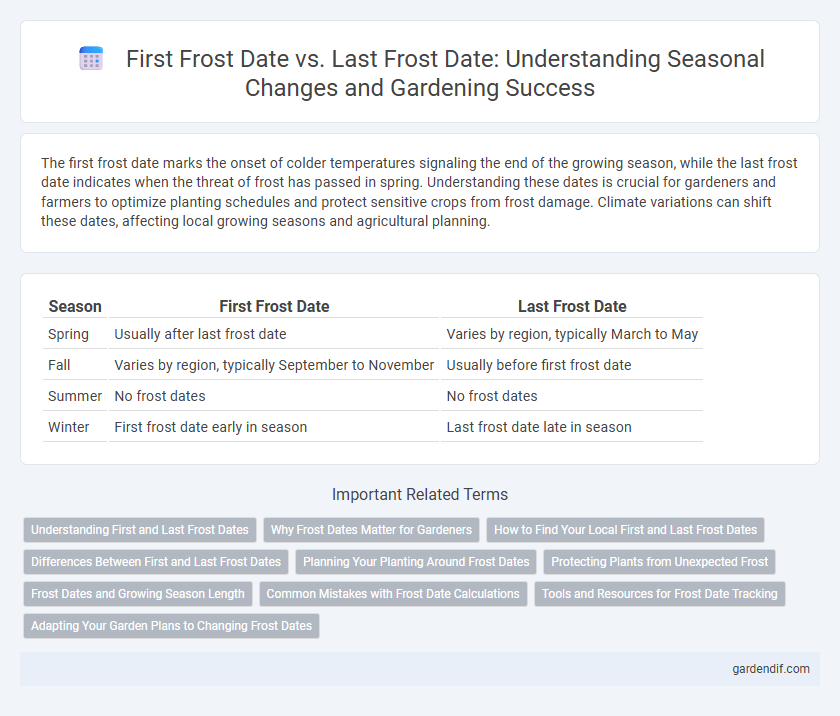
First frost date vs Last frost date Illustration
The first frost date marks the onset of colder temperatures signaling the end of the growing season, while the last frost date indicates when the threat of frost has passed in spring. Understanding these dates is crucial for gardeners and farmers to optimize planting schedules and protect sensitive crops from frost damage. Climate variations can shift these dates, affecting local growing seasons and agricultural planning.
Table of Comparison
| Season | First Frost Date | Last Frost Date |
|---|---|---|
| Spring | Usually after last frost date | Varies by region, typically March to May |
| Fall | Varies by region, typically September to November | Usually before first frost date |
| Summer | No frost dates | No frost dates |
| Winter | First frost date early in season | Last frost date late in season |
Understanding First and Last Frost Dates
First frost date marks the initial occurrence of frost in a season, signaling the onset of colder temperatures that can damage sensitive plants. Last frost date indicates the final frost event, often used by gardeners to determine safe planting times for frost-sensitive crops. Accurate knowledge of these dates helps optimize agricultural practices and protect crops from frost-related damage.
Why Frost Dates Matter for Gardeners
Understanding the first frost date and last frost date is crucial for gardeners to protect plants from cold damage and optimize planting schedules. These frost dates help determine the safe window for sowing seeds and transplanting seedlings, preventing loss from unexpected freezes. Accurate knowledge of local frost dates improves crop yield and extends the growing season by guiding timely garden management decisions.
How to Find Your Local First and Last Frost Dates
To find your local first and last frost dates, consult regional USDA Plant Hardiness Zone maps, which provide temperature averages crucial for frost occurrence. Local agricultural extensions and weather services offer historical frost data, helping gardeners identify safe planting windows. Using online frost date calculators by entering your zip code can also yield precise estimates tailored to your geographic area.
Differences Between First and Last Frost Dates
First frost date marks the initial occurrence of frost in autumn, signaling the end of the growing season, while last frost date indicates the final frost event in spring, signaling the start of planting season. The interval between these two dates defines the frost-free growing period essential for agriculture and gardening. Variability in these dates depends on geographic location, elevation, and local climate conditions, influencing planting schedules and crop selection.
Planning Your Planting Around Frost Dates
Understanding the first frost date and last frost date is crucial for planning your planting schedule to protect sensitive plants from frost damage. The last frost date marks the end of cold risk in spring, signaling the safe time to start planting frost-sensitive seeds, while the first frost date indicates when to harvest or protect plants in the fall. Efficiently timing your gardening activities based on these frost dates enhances plant survival, growth, and yield.
Protecting Plants from Unexpected Frost
Understanding the first frost date and last frost date is crucial for protecting plants from unexpected frost damage. Gardeners should use these dates to schedule planting and cover sensitive plants during early or late frost events. Employing frost cloths, mulches, and cloches helps maintain stable temperatures around plants, preventing frost injury and ensuring healthy growth throughout the season.
Frost Dates and Growing Season Length
Frost dates, including the first frost date in autumn and the last frost date in spring, are critical indicators for determining the growing season length in any region. The growing season length is calculated as the number of days between the last spring frost and the first fall frost, directly influencing planting and harvesting schedules for crops. Accurate knowledge of frost dates helps optimize agricultural practices by minimizing frost damage and maximizing crop yield.
Common Mistakes with Frost Date Calculations
Many gardeners mistakenly assume the first frost date and last frost date are fixed calendar days, leading to inaccurate planting schedules. Frost date calculations often overlook microclimate variations and annual weather fluctuations, causing errors in frost prediction. Reliance on outdated data sets instead of localized, real-time climate monitoring results in common misjudgments affecting crop success.
Tools and Resources for Frost Date Tracking
Accurate frost date tracking relies on tools like Frost Date Calculators, which use historical climate data and location-specific weather patterns to predict first and last frost dates, aiding gardeners and farmers in planning planting schedules. Weather apps and agricultural extension services offer real-time frost alerts and localized forecasts, enhancing readiness and minimizing crop damage. Utilizing soil temperature sensors and community-based frost reports further refines frost date monitoring, ensuring optimal timing for seasonal agricultural activities.
Adapting Your Garden Plans to Changing Frost Dates
Adapting your garden plans to changing frost dates involves identifying the first frost date, which marks the last expected freeze in fall, and the last frost date, signaling the end of frost risk in spring. Adjust planting schedules by selecting frost-tolerant varieties and using protective measures like row covers to extend growing seasons. Monitoring updated frost date predictions helps optimize crop selection and planting times for sustainable garden success.
First frost date vs Last frost date Infographic

 gardendif.com
gardendif.com